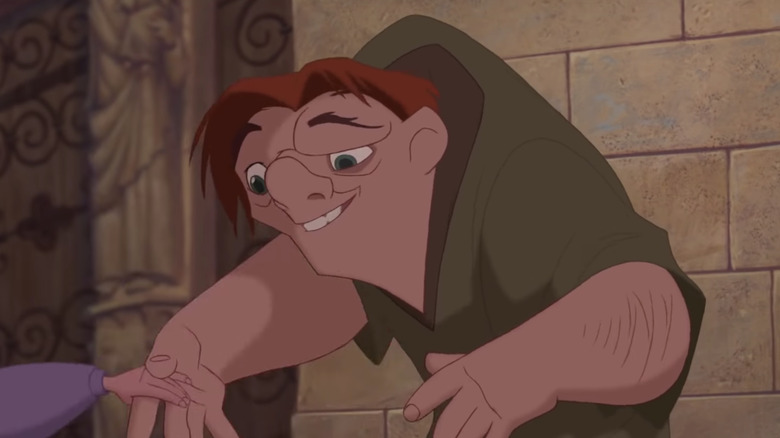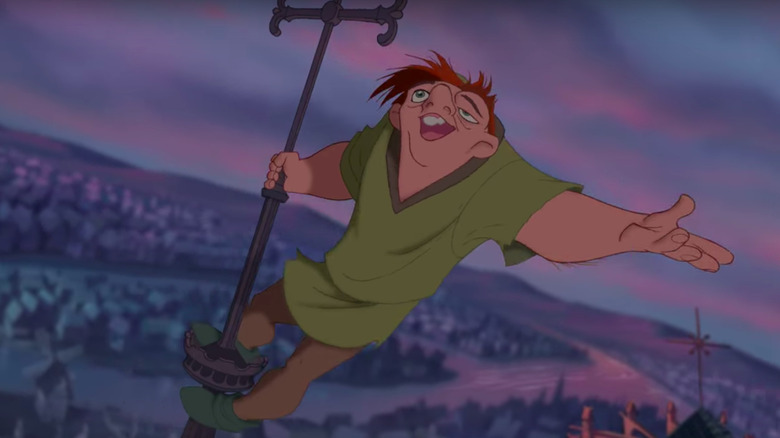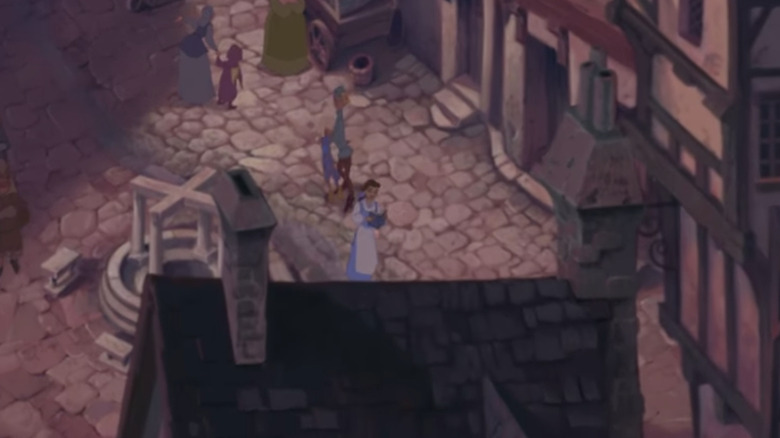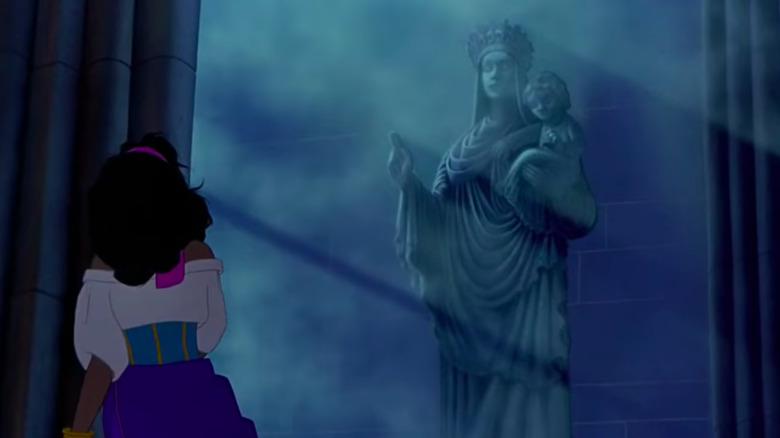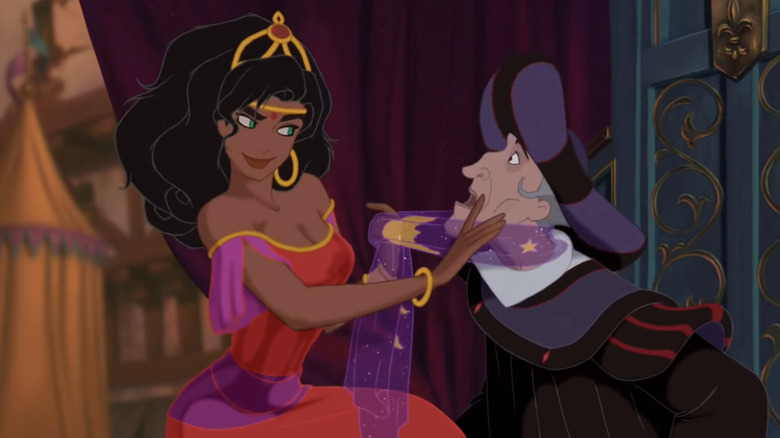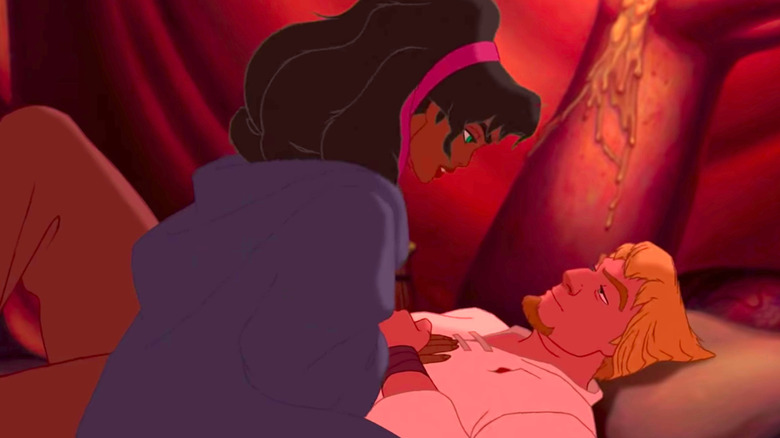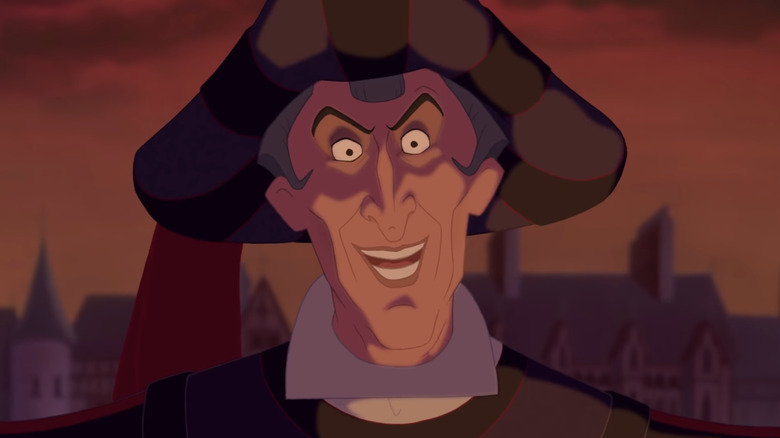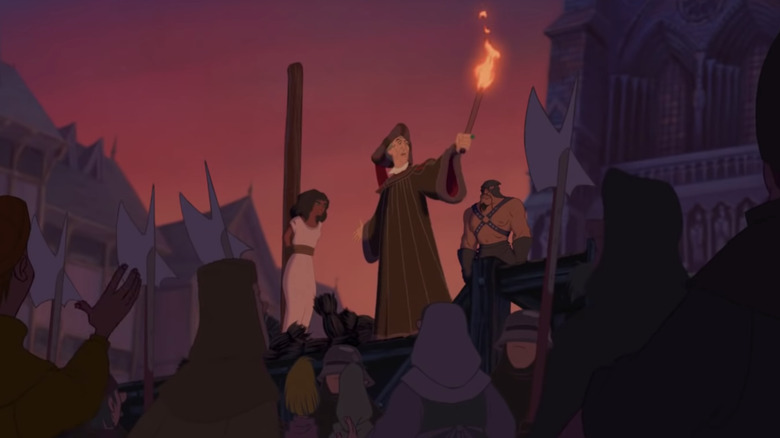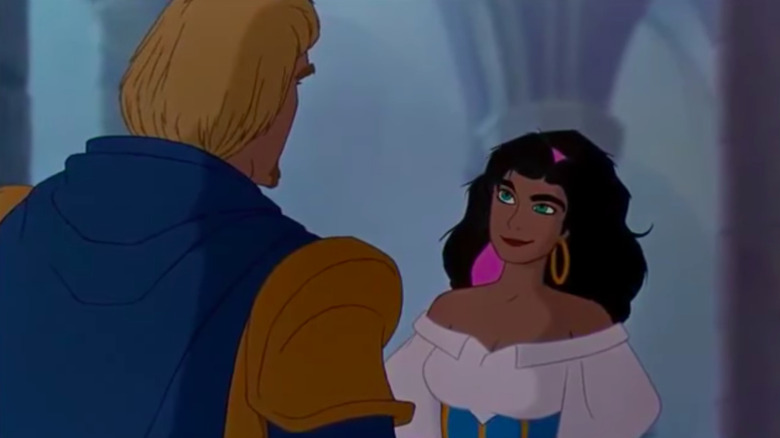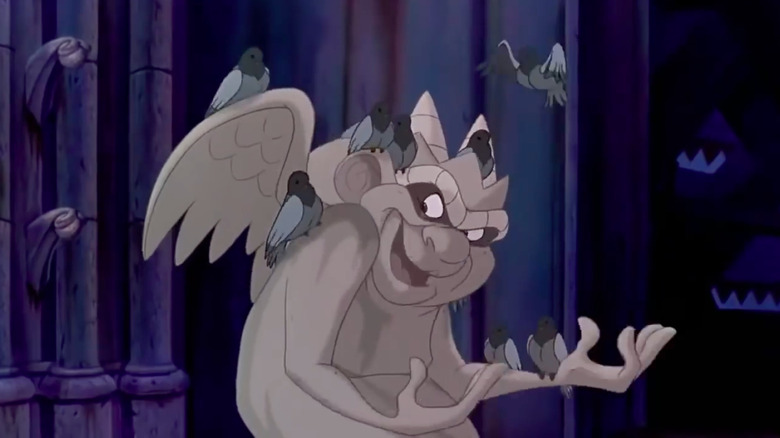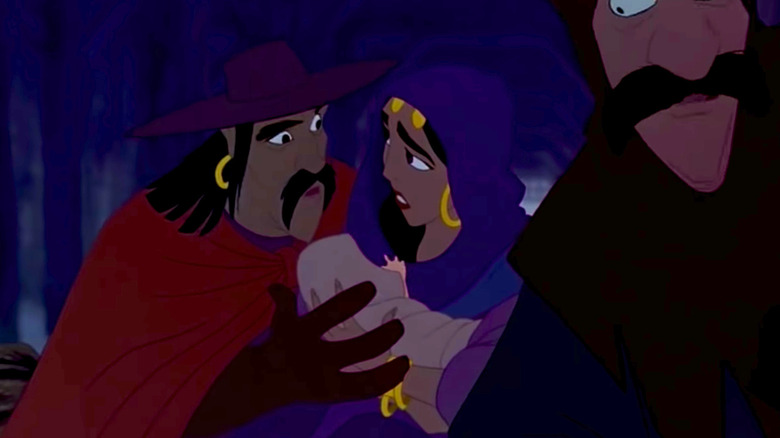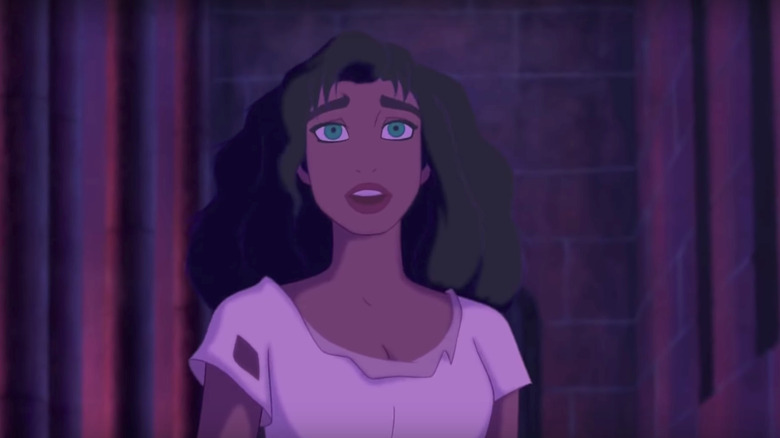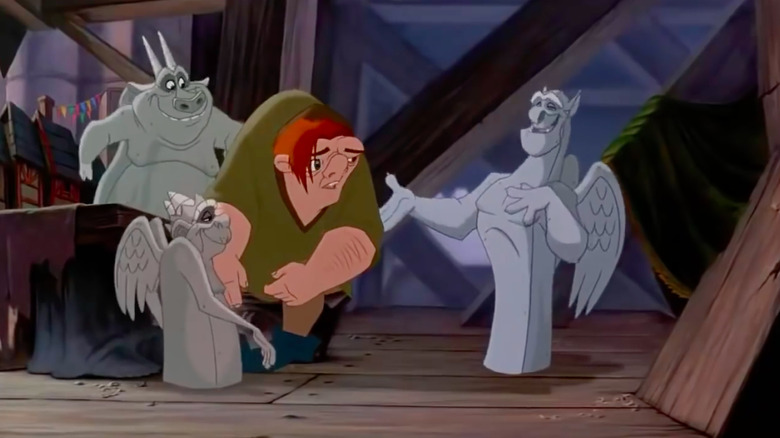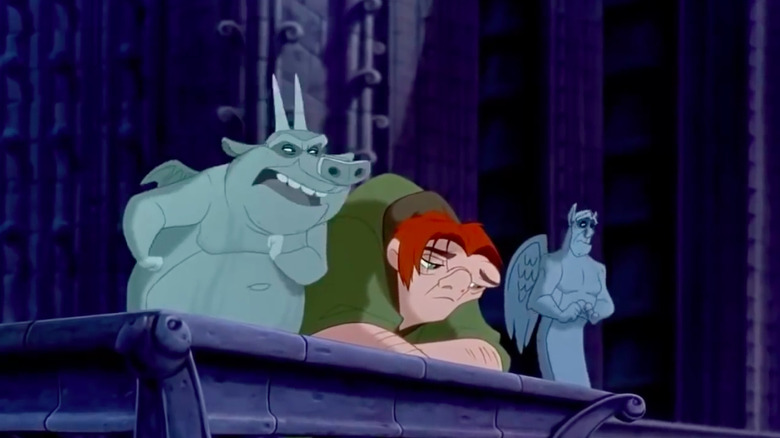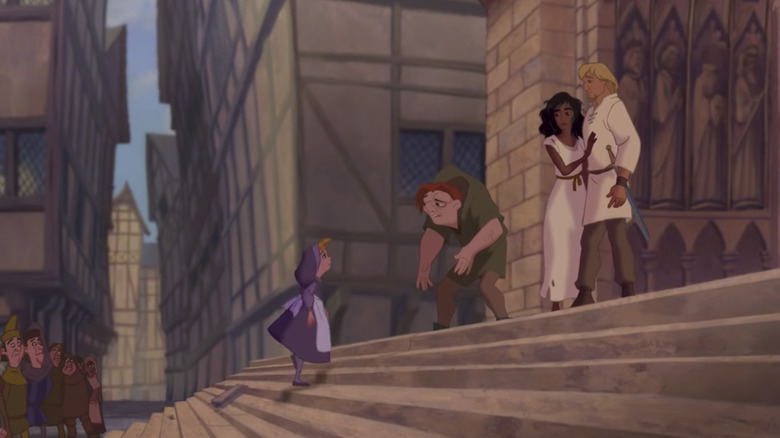The Hunchback Of Notre Dame: Things Only Adults Notice In The Disney Film
The Hunchback of Notre Dame is a Disney classic. Released in 1996, this animated feature was inspired by Victor Hugo's literary masterpiece, The Hunchback of Notre Dame (or Notre-Dame de Paris). It follows the story of a kind but lonely bell ringer, Quasimodo; his new friend, a gypsy named Esmeralda; a rebellious Captain of the Guard; and an evil judge who threatens each of their lives. As the three heroes try to escape the wicked Judge Claude Frollo, Quasimodo finds what he's always wanted: friendship and acceptance.
It's a cinematically beautiful film with top-notch music and a memorable cast of characters, but this film isn't a typical kids' movie. Like Hugo's novel, the concepts in the movie are dark and it's filled with adult themes. Luckily, many of these things went right over the heads of young viewers, but adults didn't miss them. Here are a few of the things you only notice in The Hunchback of Notre Dame as an adult.
The music in The Hunchback of Notre Dame is truly amazing
Disney has been known to go all out when it comes to making music for their animated movies. The Hunchback of Notre Dame was no different.
With music and lyrics by Disney legends Alan Menken and Stephen Schwartz, who also wrote the music for 1995's Pocahontas and 2007's Enchanted together, the soundtrack was sure to be impressive. And sure enough, this musical duo delivered hauntingly beautiful songs that brought author Victor Hugo's gothic characters to life.
Menken and Schwartz even used Latin chants and church bells to match the music with the haunting story and to utilize the cathedral's theme. This resulted in epic songs like "The Bells of Notre Dame" and "Out There," along with more playful songs like "A Guy Like You." None of which disappointed. The music ended up earning this film an Oscar nomination for best music and a Golden Globe nomination for best original score, among other nominations and awards.
Look out for Easter eggs in The Hunchback of Notre Dame
The Disney/Pixar teams love to sneak in Easter eggs. Movies like Finding Nemo and Coco feature fun moments where characters from other films pop up unexpectedly. Likewise, the animators from The Hunchback of Notre Dame also apparently wanted to have some fun.
During Quasimodo's song "Out There," the magic carpet from Aladdin can be seen being dusted off in the street by a townsperson. In the same scene, Belle from Beauty and the Beast can be spotted walking around the streets of Paris in her blue dress, holding a book. Speaking of Belle, the baker featured in the town looks identical to the baker from Beauty and the Beast. Pumbaa from The Lion King can also be spotted in this scene, as noted by HuffPost.
Additionally, when shown an aerial shot of the buildings around Notre Dame, viewers can see that one of the nearby roofs has a satellite dish on it. Filmmakers acknowledged this surprising technology by saying that the dish's owner was "way ahead of his time" (via Deseret News).
There are a ton of religious references in The Hunchback of Notre Dame
Young viewers likely understand that Notre Dame is a church, but they likely don't realize how many religious themes show up in the movie. The fact that Claude Frollo uses his political standing to gain pull with the church is a big part of the story, plus he hides behind religion when plotting nefarious deeds. Beyond that, images of the Virgin Mary and Jesus appear in the beginning when Frollo tries to drown baby Quasimodo and again when Esmeralda sings "God Help the Outcasts." People are also depicted praying in the film, and Frollo references God and sin a whole lot as well.
In the book Animated Life: A Lifetime of Tips, Tricks, Techniques and Stories from a Disney Legend, Disney animator Floyd Norman explained that the team tried their best to avoid religious themes when creating The Hunchback of Notre Dame, but it was difficult. He wrote, "We were told not to make the movie too religious — a pretty daunting task when you consider how much of this story takes place inside a big church."
The Hunchback of Notre Dame is filled with sexual themes
The Hunchback of Notre Dame deals with a lot of adult themes like death, religion, and corruption, but Disney tops it all off by adding a heavy sexual theme. While Quasimodo and Captain Phoebus' feelings for Esmeralda echo the G-rated attraction of most Disney movies past and present, the lust Judge Claude Frollo has for her is not only super creepy but also very sexual, especially for a Disney movie.
In one scene, Frollo sings the song "Hellfire" as he imagines Esmeralda dancing in fire and smoke, singing, "This fire in my skin, this burning desire is turning me to sin" and "Let her taste the fires of Hell! Or else let her be mine and mine alone."
Then, when Esmeralda is about to be executed at the end of the movie, Frollo attempts to bribe her, saying, "Choose me or the fire." That may have gone over kids' heads, but the adults know what this creep was saying.
The Hunchback of Notre Dame deals with romantic rejection
The love triangle in The Hunchback of Notre Dame is practically soap opera-worthy, with Quasimodo catching feelings for the beautiful Esmeralda almost immediately, only to watch Phoebus swoop in to woo her. But this love triangle is interesting because the titular character (spoilers!) doesn't end up with Esmeralda. Instead, the story confronts issues of romantic rejection.
It's a roller coaster of emotions with Quasimodo falling for Esmeralda, his hurt when he sees her kiss Phoebus in the bell tower, and his eventual acceptance of Phoebus and Esmeralda's relationship in a tender moment where he joins the couple's hands together.
While there have been other love triangles in Disney features before (like that love triangle with Pocahontas, Kocoum, and John Smith), The Hunchback of Notre Dame is different in that the hero is rejected and ends up without a relationship. Instead, the film depicts the pain of romantic rejection, which is just one more surprisingly adult theme in this kids' movie.
Frollo represents deadly sins in The Hunchback of Notre Dame
While Judge Claude Frollo claims to be spiritually and morally superior to everyone else in The Hunchback of Notre Dame — even saying, "You know I'm so much purer than the common, vulgar, weak, licentious crowd" as he prays to God in the song "Hellfire" — it's clear that he's far from it.
From him killing Quasi's mother at the beginning of the film to him attempting to murder the Parisian townspeople, Esmeralda, Phoebus, and Quasimodo, Judge Claude Frollo's actions prove that just about everyone in the film behaves better than him.
But only adults will notice that Frollo, who claims to be so holy, represents a good number of the deadly sins. His "burning desire" for Esmeralda displays lust, greed, and envy. He shows wrath when he threatens to burn down all of Paris, and he shows pride for his so-called virtue, which is made especially clear in lines in "Hellfire" like "You know I am a righteous man, of my virtue I am justly proud."
The Hunchback of Notre Dame is super violent
For kids satisfied in listening to the music and watching the talking statues in The Hunchback of Notre Dame, they might not even notice how violent the movie is.
While plenty of Disney movies feature death, the audience doesn't usually see the character die, and, if they do, the exact cause of their death isn't always shown. For example, in Cinderella, the audience is only told about the death of Cinderella's father. In The Lion King, the audience sees Mufasa's death scene, but, even though Mufasa falls into a stampede, he isn't shown bleeding or clearly injured in any specific way.
Meanwhile, in The Hunchback of Notre Dame, the death of Quasimodo's mother is rather violent. Viewers see her fall on the steps of Notre Dame while trying to protect Quasimodo. Later, Frollo oversees the torture of his last captain of the guard and terrorizes the townspeople, even attempting to murder one family by locking them in their house and setting it on fire. There's also plenty of violence towards the end of the movie when Frollo attempts to burn Esmeralda alive and Frollo himself falls to his death after a long battle with Quasimodo.
The Hunchback of Notre Dame has an all-star cast
Disney often gets A-list stars to bring their animated characters to life, and they weren't afraid to cast big names when it came to The Hunchback of Notre Dame. With Demi Moore playing Esmeralda, Kevin Kline playing Phoebus, and Jason Alexander playing Hugo, this film's cast is certainly star-studded.
But beyond the top-billed actors, there are plenty of other well-known voice actors in the cast list that many viewers may have missed. Mary Kay Bergman, who provided the voice for Quasimodo's mother, has portrayed multiple female voices in South Park and has played one of the Bimbettes, the three girls who fawn over Gaston, in Beauty and the Beast. Bill Fagerbakke, who played "Oafish Guard," is famous for playing Patrick Star in Spongebob Squarepants. Tony Jay, the actor behind Frollo, also played the corrupt asylum worker Monsieur D'Arque in Beauty and the Beast, and David Ogden Stiers, who played Archdeacon, voiced Governor Ratcliffe and Wiggins in Pocahontas, both Cogsworth and the narrator in Beauty and the Beast, and Jumba in Lilo & Stitch.
One character in The Hunchback of Notre Dame was played by two people
In addition to the already impressive cast of voice actors, The Hunchback of Notre Dame also featured veteran actor Mary Wickes, known best for her roles in films such as White Christmas and Sister Act, as well as plenty of television and Broadway appearances over a six-decade career. She passed away in 1995 at the age of 85, making her last film role Laverne in The Hunchback of Notre Dame. But production wasn't finished when she passed, and Wickes didn't get a chance to finish recording her lines, as noted by former The Walt Disney Company archivist Dave Smith's book Disney Trivia From the Vault: Secrets Revealed and Questions Answered.
So the film brought on Jane Withers to finish Wickes' lines. Many kids, and probably many adults, probably didn't notice the shift from Wickes' voice to Withers' voice. It would have taken a trained ear or at least a good familiarity with old Hollywood films to hear the differences. Withers apparently did a good job because she went on to reprise the role in The Hunchback of Notre Dame 2: The Secret of the Bell.
Quasimodo's mom looks nothing like him in The Hunchback of Notre Dame
In The Hunchback of Notre Dame's beginning, Clopin explains the story of how Quasimodo came to live in Notre Dame, singing, "Four frightened gypsies slid silently under the docks near Notre Dame." As he sings, the audience is shown one of these gypsies holding baby Quasimodo. It's assumed that the woman is Quasimodo's mother, but it seems likely that she wasn't his birth mother, as adult Quasimodo has different features than the woman. While she has dark hair and a darker skin tone (like other gypsies in the movie), Quasimodo is pale with red hair.
This inconsistency was probably not a mistake but done intentionally. In the original story, Esmeralda, whose birth name is Agnès, is kidnapped by gypsies as a baby and replaced with a deformed gypsy child, a 4-year-old Quasimodo. The gypsies in France would have been Roma, a people who originated in India and were known to have dark skin and hair (via Live Science). So, while Quasimodo's appearance may have been changed for the movie, the filmmakers appear to have kept his mother's background the same as it was in the book.
The Hunchback of Notre Dame is way different than the book
Disney isn't necessarily known to stick to the stories they base their animated films on, and the writers certainly took plenty of liberties with The Hunchback of Notre Dame.
Archdeacon Frollo, who is a judge in the movie, still lusts after Esmeralda in the book, but his pursuit of her is different, as is Esmeralda's relationship with Captain Phoebus. In the novel, Esmeralda falls in love with Phoebus, and Frollo becomes jealous. So he stabs Phoebus, and Esmeralda is blamed. She mistakenly admits to witchcraft and murder and is sentenced to death (via Encyclopaedia Britannica).
The Disney film skips a lot of major plot points and even some major characters like Pierre Gringoire, whom Esmeralda agrees to marry to save him from being hanged. Disney also softens the story's ending. While Frollo still falls to his death from Notre Dame, Quasimodo pushes Frollo from the tower in anger in Victor Hugo's novel. Furthermore, in the book, Esmeralda is executed, and Quasimodo goes to the cemetery to be with Esmeralda and eventually dies there. The book is much darker than the animated classic, so it's no wonder there were changes.
Quasimodo is probably hallucinating the entire time in The Hunchback of Notre Dame
Throughout the film The Hunchback of Notre Dame, Quasimodo talks to three gargoyles: Victor, Hugo, and Laverne. These three talk to Quasimodo and move around on their own, that is, until another person (such as Frollo or Esmeralda) enters the room and these three immediately return to stone. This relationship is actually inspired from the book, which mentions Quasimodo talking to the statues of Notre Dame: "He sometimes passed whole hours crouching before one of these statues, in solitary conversation with it."
It's not entirely clear if in the Disney movie these three characters are supposed to magically be coming to life, if these characters are representations of Quasimodo's personality, or if Quasimodo, who has spent his life alone in the tower, is simply hallucinating their conversations.
Kids will likely see these three characters as simply musical sidekicks, but adult viewers know it's more likely the audience is seeing Quasimodo's hallucinations.
The Gargoyles in The Hunchback of Notre Dame are named after the original story's author
Yep, that's right, two of the gargoyles, Victor and Hugo, are named after the author of Notre-Dame de Paris himself, Victor-Marie Hugo. Kids probably didn't notice the connection, but most adults probably saw the nod to the writer. Hugo, who was born in 1802 in Besançon, France and died in 1885 in Paris, was a celebrated author and poet. He published The Hunchback of Notre Dame in 1831 (via Biography).
So were Hugo's offspring proud of the appearance of the names Victor and Hugo in the movie? Apparently not. When the movie came out, five of Hugo's great-great-grandchildren wrote into a French newspaper to say they were "profoundly shocked on several counts" (via Chicago Tribune) and to denounce the movie. Not only did they think the merchandising was "scandalous and obscene," but they argued against Disney's choice to not display Hugo's name on the movie's poster.
Though it seems they didn't appreciate the gargoyles' names, plenty of viewers probably did.
Paris is cleaned up overnight at the end of The Hunchback of Notre Dame
The last scenes of the movie The Hunchback of Notre Dame are wild. Quasimodo saves Esmeralda, gypsies escape capture, and the people of Paris revolt against the guards. And yet, when Esmeralda, Phoebus, and Quasimodo emerge from Notre Dame to the awaiting crowd, the city square is spotless except for a few toppled stones.
When did the people of Paris have time to clean up? There should have presumably been blood (and maybe bodies) and wreckage — not to mention the platform and wood on which Esmeralda was going to be burned and the cages in which Frollo had locked the gypsies. Did the people of Paris defeat the guards and decide to start tidying up as Quasimodo finished fighting Frollo?
Sure, we can look upon the sudden change in time of day as a partial explanation. It appears to be sunset when Frollo tries to execute Esmeralda, and, when the three heroes leave Notre Dame, it's daytime. Maybe Disney's timeline is that they fought, recovered overnight, and left in the morning. Still, how could the townspeople have cleaned up so fast?
